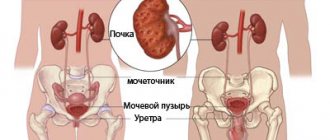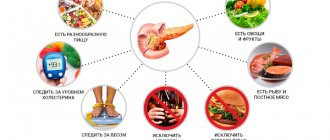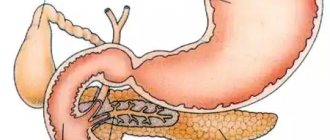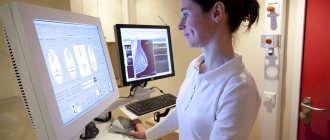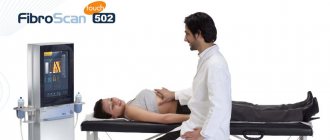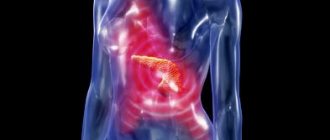Gastroenterologist
Vinogradov
Dmitry Alekseevich
6 years experience
Gastroenterologist
Make an appointment
Pain in the pancreas indicates an inflammatory process, against the background of which pancreatitis can develop. The pancreas is responsible for the digestive system and is the second largest gland after the liver. This organ is responsible for the secretion of pancreatic juice, which contains more than 30 different enzymes. Pancreatic juice enters the duodenum. In order not to destroy the tissue, the juice is initially produced in an inactive form. Afterwards, when interacting with bile, the inactive form passes into pancreatic juice. If bile enters the pancreatic flow, it leads to destruction of the pancreas and the development of various diseases. As a result of independent digestion of the glands, tissue necrosis develops, provoking the development of pancreatitis.
Causes
The reason for the development of pancreatitis of the pancreas most often lies in cholelithiasis - stones affect the outflow of bile. The development of the disease is also influenced by nutrition, monotonous diet, lack of diet, and junk food. If a patient has been diagnosed with a pathology, if he drinks excessive amounts of alcohol, this will lead to the development of pancreatitis, and if treatment is not started in a timely manner, the disease will develop into an acute and then a chronic form.
The disease affects patients who meet the following criteria:
- excess weight;
- bad habits, including smoking;
- poor nutrition;
- increased sensitivity of the body to food;
- taking medications for a long time.
Against the background of these criteria, pancreatitis of the pancreas occurs. The cause of chronic pancreatitis is viruses, infections, bacteria, for example, hepatitis C.
The main factors influencing the development of the disease include:
- structure of gland flows;
- injuries resulting in damage to the pancreas;
- features of the pancreas;
- blood supply features;
- anatomical features.
It is also necessary to highlight the following reasons for the progression of acute pancreatitis:
- worms;
- diseases, inflammatory processes of the duodenum;
- impaired metabolism;
- tumors;
- disruptions in hormonal levels.
People aged 40 to 60 years are at risk. If pancreatitis is diagnosed in a small child, this is a congenital defect.
Diseases during pregnancy
Pregnancy can lead to the appearance of an inflammatory process in a woman’s pancreas. It is difficult to diagnose pathology based on clinical manifestations, because pregnancy causes displacement of internal organs as a result of an enlarged uterus. The following factors for the development of pathology are identified:
- unbalanced diet, which provokes digestive disorders;
- compression of the gland by the enlarged uterus;
- excessive physical activity;
- use of certain medications.
This provokes an increased secretion of enzymes, causing self-digestion of the gland. If unpleasant symptoms develop, consult a doctor. Treatment of any deviations should be carried out under the supervision of the attending physician. Self-medication can cause the development of new pathologies in a woman and unborn child
.
When diagnosing phlegmon or an abscess, urgent surgical intervention is required. If the pathology is established at the beginning of pregnancy, then an abortion is performed; in the third trimester, an urgent delivery is performed.
Pathologies of the digestive gland can provoke dangerous complications; to avoid this, timely diagnosis and therapy are necessary. Therefore, when the first unpleasant symptoms develop, you should immediately consult a specialist.
Symptoms and signs
The symptoms of pancreatitis cannot be determined immediately; the doctor will make such a diagnosis only after an examination. The first signs of pancreatitis are general, including:
- nausea;
- vomit;
- increased body temperature;
- bloating;
- stomach upset.
If you do not pay attention to these manifestations in a timely manner, severe pain will be added to the symptoms of pancreatitis in adults.
Symptoms of chronic pancreatitis (also suitable for the acute form) include:
- severe pain in the epigastric region, radiating to the left shoulder blade;
- bile coming out with vomiting;
- the skin acquires a yellow tint.
Acute pancreatitis is accompanied by bloating, heartburn, blue spots may appear on the body, and traces of hemorrhage will appear in the navel area. Patients complain of pain on the left in the upper part of the stomach and in the middle. When advanced, this pain can radiate to the back. With chronic pancreatitis, pain sensations may change in nature, for example, the frequency of pain will decrease, and instead cramping pain will appear near the navel. Mucous masses will be released along with the feces. Since there will be a large number of bacteria in the intestines, digestion will be disrupted. This will lead to a deterioration in appetite (or complete loss depending on the form of the disease), copious amounts of feces, diarrhea, and against this background food allergies may develop.
Unstable food intake or complete refusal to eat will lead to exhaustion of the body. In addition to weight, a person loses vitamins, important microelements, and minerals that enter the body with food. Dehydration also develops, gastric motility is impaired, and the bladder is not completely emptied. Chronic pancreatitis in the later stages of progression is characterized by problems with the production of insulin and glucagon. This leads to the development of diabetes mellitus.
Are you experiencing symptoms of pancreatitis?
Only a doctor can accurately diagnose the disease. Don't delay your consultation - call
Diabetes
Pancreas as a vital organ
Diabetes mellitus is another of the most common diseases of the pancreas, which is associated with the lack of insulin production. In most cases, diabetes develops gradually, thereby sometimes smoothing out all the symptoms and allowing the person to get used to them. And this is very dangerous. The main signs that a person has diabetes include:
- Feeling of dry mouth. Moreover, the feeling will be constant, and even if you drink a large amount of water, it will not go away
- Increased urine output
- A sharp increase, and in some cases a sharp decrease in a person’s weight
- Dry skin
- Formation of pustules on the skin
- Constant feeling of muscle weakness
- Severe, even small wounds take a very long time to heal
If the disease has progressed to a more severe stage, then the person’s vision may deteriorate, wounds begin to appear that take a very long time to heal, constant headaches are tormented, consciousness is impaired, and a persistent smell of acetone is felt from the person’s skin. The main causes of diabetes include:
- Heredity. Those at risk are those whose parents or grandparents had this disease
- Excess weight
- Stress
- Age. Scientists have proven that the older a person is, the more likely he is to develop diabetes.
Due to the fact that the body stops producing insulin, it needs to be replenished. Quite often, patients are prescribed insulin injections. If the stage of diabetes is mild, then you can get by by taking pills or following a strict diet.
When should you make an appointment with a doctor?
If nausea does not go away for a long time, it is accompanied by vomiting, diarrhea, or an increase in body temperature, you need to consult a doctor. Often these symptoms are confused with food poisoning and mild stomach upsets. This may be an exacerbation of pancreatitis. A gastroenterologist treats pancreatitis; he will diagnose, prescribe treatment, and monitor the healing process. The examination is carried out using new equipment, doctors use modern treatment methods. JSC "Medicine" (clinic of academician Roitberg) is located in the center of Moscow, at 2nd Tverskoy-Yamskaya lane 10, not far from the metro stations Chekhovskaya, Mayakovskaya, Belorusskaya, Novoslobodskaya, Tverskaya.
Diagnostics
Chronic pancreatitis is the most difficult to treat and diagnose; it progresses as a separate disease and does not always act as a form of acute pancreatitis.
Diagnostics at JSC "Medicine" (clinic of academician Roitberg) may consist of the following stages:
- taking a general blood test;
- biochemical analysis of blood and urine;
- taking a stool test;
- ultrasonography;
- multislice computed tomography;
- gastroscopy;
- MRI.
To prevent the disease, it is recommended to undergo regular preventive medical examinations, including visits to a gastroenterologist. If necessary, the specialist prescribes an x-ray of the abdominal cavity, an x-ray examination that allows you to see the condition of the stomach and duodenum.
Where is the pancreas located?
The pancreas is located in the abdominal cavity behind the stomach, closely adjacent to it and the duodenum, at the level of the upper (first-second) lumbar vertebrae. Let's take a closer look at where the human pancreas is located. In the projection onto the abdominal wall, it is located 5-10 cm above the navel. The pancreas has an alveolar-tubular structure and consists of three sections: head, body and tail.
The head of the pancreas is located in the flexure of the duodenum so that the intestine encloses it in the shape of a horseshoe. It is separated from the body of the gland by a groove through which the portal vein passes. The blood supply to the pancreas is carried out through the pancreatic-duodenal arteries, and the outflow of blood occurs through the portal vein.
The body of the pancreas is divided into anterior, posterior and inferior surfaces.
It also has upper, anterior and lower edges. The anterior surface is adjacent to the posterior wall of the stomach, slightly below. The posterior surface is adjacent to the spine and abdominal aorta. The vessels of the spleen pass through it. The lower surface is located below the root of the transverse colon. The tail of the gland is cone-shaped, directed upward and to the left and reaches the gate of the spleen.
The pancreas consists of 2 types of tissue that perform different functions (endocrine and exocrine). Its main tissue consists of small lobules - acini, which are separated from each other by layers of connective tissue. Each lobule has its own excretory duct. Small excretory ducts connect with each other and merge into a common excretory duct, which runs through the thickness of the gland along its entire length, from tail to head. At the right edge of the head, the duct opens into the duodenum, connecting with the common bile duct. Thus, the pancreatic secretion enters the duodenum.
Treatment
Treatment of acute pancreatitis begins with the elimination of pain. At the first stages of treatment, the specialist is faced with the task of removing the heaviness from the pancreas and the load on it. It is also important to direct treatment to stimulate self-healing.
Treatment depends on the form of the disease; at JSC “Medicine” (clinic of Academician Roitberg) the following methods are practiced:
- medicinal (the doctor prescribes medications after a full examination);
- a diet is prescribed for pancreatitis of the pancreas;
- gastric contents are aspirated.
Treatment of pancreatitis in adults can be done on an outpatient or inpatient basis. The chronic form should be treated in a clinic under the supervision of a specialist. For severe pain, the patient may be prescribed drugs that have a narcotic effect, for example, narcotic analgesics.
During the treatment of pancreatitis, it is important to adhere to the correct diet; the doctor may even prescribe fasting. To relieve pain, ice is placed on the area where the gland is projected. The clinic employs qualified nutritionists who develop a diet for each patient individually. Dishes should be low-calorie, mechanically and chemically gentle on the body. If the disease is the result of excessive drinking or smoking, a psychologist works with patients to help patients get rid of bad habits. Surgical interventions are carried out on the territory of the clinic; experienced surgeons with many years of experience work here.
Take into account! The chronic form of pancreatin can develop into a malignant tumor, so it is not recommended to delay treatment or ignore the doctor’s recommendations.
If not treated in a timely manner, the chronic stage develops into serious diseases that can lead to death. The course of treatment is aimed at restoring the pancreas; in addition to medication and diet, gallstone diseases are treated. It is prescribed only after a complete examination of the patient.
Localization of pain
The pain can be severe or mild, the pain can be prolonged or increasing, intense, sharp, stabbing. Which organ exactly hurts? Statistics show:
- men have gastrointestinal pain 35% more often than women,
- liver pain due to alcohol - in 45% of cases this ends in the death of the patient,
- acute pancreatitis is fatal in 17% of cases.
How to understand that the pancreas hurts or identify gastritis, ulcers, reflux, duodenitis, colitis at an early stage? Adequate diagnosis at the first manifestations of pain is extremely important. How to determine if your stomach or pancreas hurts? To do this you need to listen to the pain. It is advisable to determine whether it has a specific localization.
The main indicator is if severe pain appears on the right and left sides, and is also observed in the lumbar region, that is, there is girdling pain.
Diagnosis and specific symptoms are different for each form, although there are some similar general manifestations. Gastritis (inflammation of the mucous membrane of different parts of the stomach) can cause:
- heartburn, vomiting, belching (with limited gastritis at the outlet of the stomach),
- a feeling of heaviness, sometimes belching, as with severe overeating (a chronic process that leads to the occurrence of ulcers).
How to make an appointment with a gastroenterologist
You can make an appointment with a gastroenterologist by calling +7 (495) 775-73-60. The line operates 24 hours a day and accepts calls from English-speaking citizens. In case of acute attacks, it is recommended to call an ambulance by phone. Calls are accepted around the clock, the clinic is open both on weekdays and on weekends, and there is a hospital on the territory of the medical institution. Doctors with extensive experience work here. You can also use the form to make an appointment with a doctor provided on the website. JSC "Medicine" (clinic of academician Roitberg) is located in the center of Moscow, at 2nd Tverskoy-Yamskaya lane 10.
